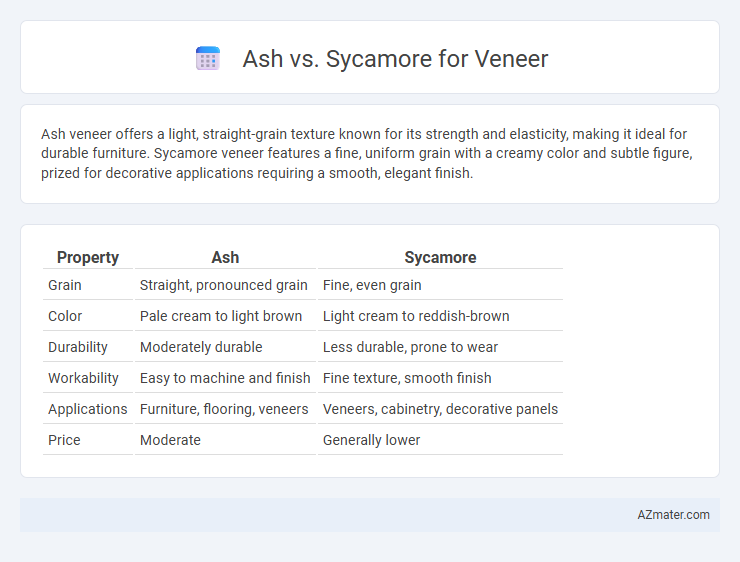Ash veneer offers a light, straight-grain texture known for its strength and elasticity, making it ideal for durable furniture. Sycamore veneer features a fine, uniform grain with a creamy color and subtle figure, prized for decorative applications requiring a smooth, elegant finish.
Table of Comparison
| Property | Ash | Sycamore |
|---|---|---|
| Grain | Straight, pronounced grain | Fine, even grain |
| Color | Pale cream to light brown | Light cream to reddish-brown |
| Durability | Moderately durable | Less durable, prone to wear |
| Workability | Easy to machine and finish | Fine texture, smooth finish |
| Applications | Furniture, flooring, veneers | Veneers, cabinetry, decorative panels |
| Price | Moderate | Generally lower |
Introduction to Ash and Sycamore Veneers
Ash veneer is prized for its prominent grain patterns and light color, making it a popular choice for furniture and cabinetry that require a natural, warm aesthetic. Sycamore veneer offers a smoother texture with subtle, wavy grain lines and a creamy, pale tone, providing a refined and elegant surface ideal for decorative panels and high-end interior finishes. Both veneers are valued for their durability and versatility, with ash delivering robust strength and sycamore offering a delicate, uniform appearance for diverse woodworking projects.
Botanical Origins and Characteristics
Ash veneer, derived from the Fraxinus genus, is prized for its light color, prominent grain, and durability, making it a popular choice in furniture and flooring. Sycamore veneer, sourced from the Platanus genus, features a creamy to light brown tone with a distinctive, swirled grain pattern and a smooth texture, lending an elegant appearance to woodworking projects. Both woods offer unique botanical characteristics that influence their grain structure, hardness, and suitability for different veneer applications.
Grain Pattern and Aesthetic Appeal
Ash veneer features a pronounced, straight grain pattern with a uniform texture that enhances modern and rustic designs, providing a bright, airy aesthetic suited for contemporary interiors. Sycamore veneer displays a more varied and intricate grain with subtle swirls and occasional birdseye patterns, offering a decorative and elegant look valued in high-end furniture and cabinetry. The choice between ash and sycamore veneers depends on whether a consistent, linear grain or a unique, textured appearance is preferred for the finished surface.
Color Variations in Ash and Sycamore
Ash veneer exhibits a broad spectrum of color variations, ranging from pale creamy white to light brown with occasional yellow or reddish hues, creating a warm and inviting aesthetic. Sycamore veneer typically presents a lighter, more uniform appearance with subtle shades of creamy white to light beige, often accented by delicate, curly grain patterns that enhance its visual texture. Both veneers offer distinct color characteristics that cater to diverse design preferences, with ash providing more pronounced contrast and sycamore favoring a softer, more consistent tonal palette.
Durability and Strength Comparison
Ash veneer exhibits superior durability and strength compared to sycamore veneer, making it ideal for high-traffic furniture and flooring applications. Ash wood's dense grain structure provides excellent resistance to impact and wear, while sycamore's softer composition results in easier denting and scratching. For projects requiring long-lasting performance and structural integrity, ash veneer is the preferred choice over sycamore.
Workability and Machining Properties
Ash veneer is highly regarded for its excellent workability, offering smooth slicing and consistent grain patterns that enhance aesthetic appeal. Sycamore veneer features moderate workability, with a fine, even texture that responds well to light sanding and finishing but may require more care during machining to avoid tear-out. Both veneers machine efficiently on CNC routers and saws, though ash provides a slightly better surface finish with less tool wear due to its uniform hardness.
Common Applications in Furniture and Design
Ash and sycamore veneers are highly sought after in furniture and interior design for their distinct aesthetic qualities and workability. Ash veneer, known for its prominent grain and light color, is commonly used in crafting modern furniture, cabinetry, and flooring to achieve a bright, airy ambiance with durable surfaces. Sycamore veneer, appreciated for its subtle, wavy grain and creamy hue, finds frequent application in fine furniture, decorative panels, and high-end cabinetry, enhancing spaces with elegance and smooth texture.
Cost and Availability of Veneers
Ash veneers are generally more affordable and widely available due to the wood's abundance in North America, making it a cost-effective choice for large-scale projects. Sycamore veneers tend to be pricier, reflecting their relative scarcity and the intricate grain patterns valued in fine furniture and decorative applications. Availability of ash allows for consistent supply with minimal lead times, whereas sycamore veneers may require longer sourcing periods and higher procurement costs.
Sustainability and Environmental Impact
Ash veneer is highly valued for its rapid regrowth and carbon sequestration, making it a sustainable choice in woodworking projects, while sycamore veneer offers a similar environmental benefit due to its fast growth rate and low pesticide requirements. Both wood types contribute to reducing deforestation when sourced from responsibly managed forests certified by organizations such as FSC or PEFC. Choosing ash or sycamore veneer supports eco-friendly practices by promoting renewable materials with lower ecological footprints compared to tropical hardwoods.
Choosing the Right Veneer: Ash vs Sycamore
Choosing between ash and sycamore veneer depends on the desired appearance and durability for your project. Ash veneer offers a prominent grain pattern with a light, creamy color that adds warmth and character to furniture and cabinetry, while sycamore veneer provides a finer, more uniform grain with a pale, almost white tone ideal for modern, clean aesthetics. Consider ash for its strength and rustic charm, whereas sycamore suits applications requiring smooth texture and subtle elegance.

Infographic: Ash vs Sycamore for Veneer
 azmater.com
azmater.com